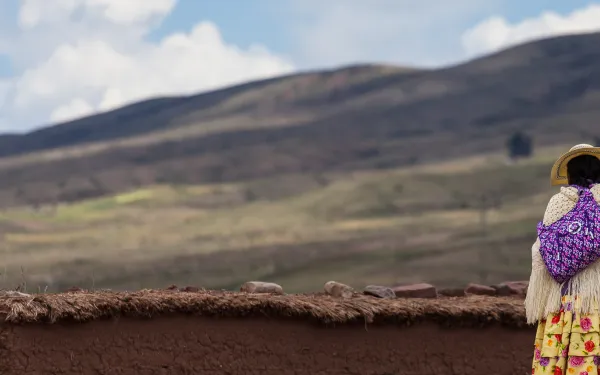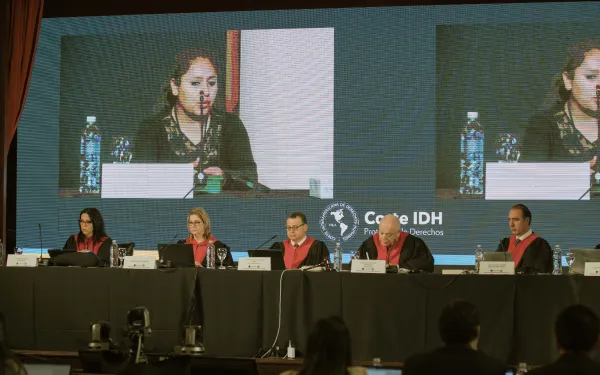
Project
Photo: Ana Rodríguez Carrington (CC BY 2.0)Victory: Biosphere Reserve in Baja California Saved from Toxic Mine
Known as an “ecological treasure house,” the Sierra La Laguna Biosphere Reserve at the southern tip of Baja California will not be spoiled by toxic mine waste, thanks in part to AIDA’s advocacy.
The reserve was once an island, so it’s home to rare plant and animal species. Canyons, swimming holes, and hot springs can be found in its granite mountain range and lowland tropical forests.
Thanks to AIDA and our partners in Mexico, the Mexican government denied an environmental permit for the Paredones Amarillos gold mine, halting the project for the time being. To protect the biosphere reserve, AIDA helped educate community groups and decision makers about the mine's risks. This helped to build the political momentum necessary for the government to deny the permit.
To extract gold from the mountains, the Canadian company Vista Gold proposed to carve out huge quantities of rock—each ton containing a mere gram of gold–-grind it into sludge, and treated it with cyanide. The company planned to dump massive amounts of toxic waste (called “tailings”) behind a dam intended to store it forever. Unfortunately, tailings dams can break for various reasons, as happened at Bolivia’s Porco mine in 1996. When that dam collapsed, more than a quarter million metric tons of tailings flooded the river and contaminated 500 miles (800 km) of waterways in Bolivia, Argentina and Paraguay.
The mine could also cause acid mine drainage. When sulfur-containing rocks are exposed to air and water, sulfuric acid forms, which causes toxic heavy metals to dissolve and drain into the watershed. The risk of acid mine drainage in Sierra La Laguna was significant and the human and environmental cost would have been tremendous: thousands of people and countless wildlife in the reserve rely on its water for survival.
Depleting freshwater is a further threat because mines use tremendous quantities of water. Owing to the scarcity of water in the reserve, Vista Gold proposed to build a plant on the Pacific coast to remove salt from sea water in a highly energy-intensive process, and then pump the water 45 km to the mine site. The desalination plant posed a threat to the endangered leatherback sea turtle.
Singly and together, the mine’s impacts would have devastated a rare jewel, a unique and lush paradise worth saving for future generations.
Related projects

Toward environmental justice: 4 achievements for AIDA in 2022
Success stories are the result of processes that take time, perseverance and joint actions. Faced with the challenges of environmental degradation and the climate crisis, these precepts are more relevant than ever. They are a reminder that the defense of the environment is collective and long-term. For AIDA, 2022 was a year of important achievements in our efforts to contribute to environmental and climate justice in Latin America. These advances demonstrate the importance of collaboration and persistence. They are in turn precedents for litigation, advocacy and alliance-building in favor of the broader regional movement of which we are a part. 1. LA OROYA POLLUTION VICTIMS HEARD BY INTER-AMERICAN COURT People affected by toxic contamination from a metal smelter in the Andean city of La Oroya, Peru, presented their case before the Inter-American Court of Human Rights. More than 20 years after taking the case, AIDA succeeded in presenting their case before the international court and demonstrating the Peruvian government's responsibility in the violation of their rights. The eventual ruling is a historic opportunity to establish a key precedent upholding the right to a healthy environment in Latin America. LEARN MORE 2. DIGITAL PLATFORM STRENGTHENS CLIMATE LITIGATION IN LATIN AMERICA Climate litigation has the power to accelerate corporate and government accountability in the face of the climate crisis, and push actions to protect communities and ecosystems. To strengthen this growing movement, we created the Climate Litigation Platform for Latin America and the Caribbean, which currently displays more than 50 legal cases involving climate arguments. It is our contribution to facilitating the exchange of strategies and arguments among those who use the courts to defend the planet. LEARN MORE 3. INTERNATIONAL AGREEMENT CONTRIBUTES TO OCEAN RESILIENCE AIDA was part of the efforts of organizations, governments, academia and the private sector to reach a binding agreement at the World Trade Organization to curb harmful fisheries subsidies, including those that encourage illegal, overfished and unregulated fishing on the high seas. This will help reduce threats to the ocean, a key ally in addressing the climate crisis due to its ability to absorb the planet's excess heat and carbon dioxide emissions. LEARN MORE 4. REGIONAL ALLIANCE ELEVATES THE VOICE OF THE CLIMATE JUSTICE MOVEMENT In response to the need to change the narrative about the climate crisis and strengthen the voice of the movement for a just energy transition in the region, Presentes was born, an alliance coordinated by AIDA that brings together organizations, communities and environmental advocates. We joined together to communicate more strategically and reach more people through the exchange of knowledge and experiences, pedagogy, the use of digital tools and internal capacity building LEARN MORE We invite you to learn more about these achievements and AIDA's work during the year in our 2022 Annual Report
Read more
Toward environmental justice: 4 achievements for AIDA in 2022
Success stories are the result of processes that take time, perseverance and joint actions. Faced with the challenges of environmental degradation and the climate crisis, these precepts are more relevant than ever. They are a reminder that the defense of the environment is collective and long-term. For AIDA, 2022 was a year of important achievements in our efforts to contribute to environmental and climate justice in Latin America. These advances demonstrate the importance of collaboration and persistence. They are in turn precedents for litigation, advocacy and alliance-building in favor of the broader regional movement of which we are a part. 1. LA OROYA POLLUTION VICTIMS HEARD BY INTER-AMERICAN COURT People affected by toxic contamination from a metal smelter in the Andean city of La Oroya, Peru, presented their case before the Inter-American Court of Human Rights. More than 20 years after taking the case, AIDA succeeded in presenting their case before the international court and demonstrating the Peruvian government's responsibility in the violation of their rights. The eventual ruling is a historic opportunity to establish a key precedent upholding the right to a healthy environment in Latin America. LEARN MORE 2. DIGITAL PLATFORM STRENGTHENS CLIMATE LITIGATION IN LATIN AMERICA Climate litigation has the power to accelerate corporate and government accountability in the face of the climate crisis, and push actions to protect communities and ecosystems. To strengthen this growing movement, we created the Climate Litigation Platform for Latin America and the Caribbean, which currently displays more than 50 legal cases involving climate arguments. It is our contribution to facilitating the exchange of strategies and arguments among those who use the courts to defend the planet. LEARN MORE 3. INTERNATIONAL AGREEMENT CONTRIBUTES TO OCEAN RESILIENCE AIDA was part of the efforts of organizations, governments, academia and the private sector to reach a binding agreement at the World Trade Organization to curb harmful fisheries subsidies, including those that encourage illegal, overfished and unregulated fishing on the high seas. This will help reduce threats to the ocean, a key ally in addressing the climate crisis due to its ability to absorb the planet's excess heat and carbon dioxide emissions. LEARN MORE 4. REGIONAL ALLIANCE ELEVATES THE VOICE OF THE CLIMATE JUSTICE MOVEMENT In response to the need to change the narrative about the climate crisis and strengthen the voice of the movement for a just energy transition in the region, Presentes was born, an alliance coordinated by AIDA that brings together organizations, communities and environmental advocates. We joined together to communicate more strategically and reach more people through the exchange of knowledge and experiences, pedagogy, the use of digital tools and internal capacity building LEARN MORE We invite you to learn more about these achievements and AIDA's work during the year in our 2022 Annual Report
Read more
Organizations, coalitions, academia, and specialists support victims of toxic contamination in La Oroya
Experts filed 15 amicus briefs before the Inter-American Court of Human Rights upholding the central argument of the case: that the government of Peru is responsible for violating the human rights of residents of La Oroya for the lack of urgent and effective actions to address pollution from a metal smelter, and its harmful effects. San José, Costa Rica. Organizations, coalitions, academia, and specialists presented 15 legal briefs (Amicus curiae) before the Inter-American Court of Human Rights to support the case of residents of La Oroya against the government of Peru, for human rights resulting from a metal plant spewing toxic pollution into the Andean city for nearly 90 years. The briefs contain solid evidence that support the central argument of the case: that the Peruvian government—by not taking urgent and effective action to address the pollutions and its effects—is responsible for the violation of the rights to life, health, personal integrity, childhood, and a healthy environment of the residents of La Oroya. This argument as expressed in a public audience on October 12 and 13, when the international court heard from witnesses, experts, victims, and government representatives. The briefs, sent to the Court between October 11 and 28, demonstrate that the importance of the case surpasses the Peruvian context and represents a historic opportunity to establish a key precedent in Latin America, and the world, that strengthens the right to a healthy environment and government’s role supervising business activities. One of the briefs was presented by the University Network for Human Rights in partnership with a panel of experts: five former authorities from the Inter-American Commission on Human Rights (Tracy Robinson, James Cavallaro, Paulo de Tarso Vannuchi, Flávia Piovesan and Paulo Abrão) and three former Special Rapporteurs to the United Nations (John Knox, James Anaya, and Juan Méndez). Briefs were presented by Peruvian organizations— including the Technical Committee for Environmental and Human Health and the Civil Society Platform on Business and Human Rights—as well as from other countries in Latin America—the Mexican Center for Environmental Law (Mexico), Defensoria Ambiental (Chile), and Justice for Nature (Costa Rica)—and international organizations such as Earthjustice and The Center for Justice and Environmental Law. Furthering the international scope of the hearing, The Working Group for Strategic Litigation of Red-DESC and the United Nations Working Group on Business and Human Rights. From the academic sector, support came from the Human Rights Research and Education Center of the University of Ottawa (Canada), the Clinic for Human Rights of the Postgraduate Law School of the Pontificia Catholic University of Paraná (Brazil), and the Legal Clinic of Environmental and Public Health of the University of the Andes (Colombia). Other writings were presented by experts on the issues that the case addresses: David R. Boyd, Special Rapporteur to the UN on human rights and the environment, medical anthropologist Susana Ramírez, and attorneys Carla Luzuriaga-Salinas, Macarena Martinic Cristensen, and Ezio Costa Cordella. Following the hearing and the briefs, the next step in the legal process is to present written closing arguments a potential visit to La Oroya by the judges from the Court. The sentence, which cannot be appealed, is expected within six months. press contact Víctor Quintanilla (Mexico), AIDA, [email protected], +525570522107
Read more